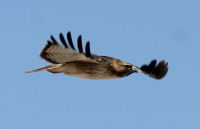 “…Killing rare protected species was a crime at both the state and federal level. So with the help of government agencies, the industry went to work stripping and changing environmental laws…”—Jim Wiegand
“…Killing rare protected species was a crime at both the state and federal level. So with the help of government agencies, the industry went to work stripping and changing environmental laws…”—Jim Wiegand
By Jim Wiegand, wildlife biologist
February 25, 2013 (San Diego's East County)-- In 1984 the California Energy Commission made the following statement in their Wind Energy Program Progress Report., "The development of wind energy in California has been very rapid, and the foundations for a significant new domestic energy industry are in place. As should be expected however, with any fast growing industry using a new technology, there are many institutional, engineering, environmental, and economic issues which must be resolved before the industry is secure and it growth assured."
Though it was not clearly stated, the primary environmental issue the California Energy Commission was speaking about was the extreme hazard that wind turbines posed to raptors. With over 4700 wind turbines installed by 1984, the industry was already experiencing a horrendous number of raptors being killed by turbine blade strikes. This mortality issue, even though the California Energy commission said it must be resolved, has never resolved. Instead these impacts have been covered up, so this industry could market this killer to America.
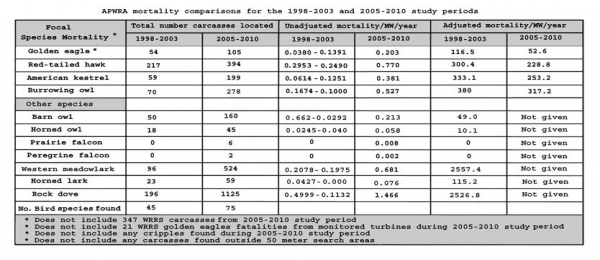 Raptor mortality was one of two primary obstacles for this industry, the other was environmental law. At the time killing rare protected species was a crime at both the state and federal level. So with the help of government agencies, the industry went to work stripping and changing environmental laws so their industry would be appear to be compliant. This process took over 25 years and it to this day is still going on with laws pertaining to the killing of bald eagles and whooping cranes by wind turbines. But despite how any of these laws currently read, there is nothing about the killing of rare species by turbines that is "incidental." The industry is completely aware of the dangers from their turbines, and every move they make is highly calculated, including their hidden slaughter.
Raptor mortality was one of two primary obstacles for this industry, the other was environmental law. At the time killing rare protected species was a crime at both the state and federal level. So with the help of government agencies, the industry went to work stripping and changing environmental laws so their industry would be appear to be compliant. This process took over 25 years and it to this day is still going on with laws pertaining to the killing of bald eagles and whooping cranes by wind turbines. But despite how any of these laws currently read, there is nothing about the killing of rare species by turbines that is "incidental." The industry is completely aware of the dangers from their turbines, and every move they make is highly calculated, including their hidden slaughter.
Since the early 1980's, the industry has known that there was no way to ever make their propeller style wind turbine design safe for raptors. With the exposed blades tip spinning in open space at 200 mph, it was impossible.
The industry has also known for decades that they were sitting on a public relations nightmare. Images of eagles and hawks cut in half or wandering around wind farms for days with limbs missing would not set well with people. But it does happen and it happens often. To hide this unsettling truth, strict wind farm operating guidelines were established long ago. Some of these guidelines were to maintain high security at wind farms, require strict gag orders from lease holders and employees, and to avoid meaningful studies. For the industry this business plan has succeeded quite well in keeping a lid on their mortality problem.
While the public has some understanding that birds are killed by wind turbines, they haven't a clue about the "numbers". I happen to have a good idea because of my extensive wildlife background and the research I've done relating to this industry. I can not give precise numbers without conducting my own studies, but I certainly understand enough to say with complete certainty that the vast majority of mortalities caused by wind turbines are not being reported. For me this is especially disturbing because the cumulative damage of killing thousands of raptors and rare species a year from limited populations will eventually have disastrous consequences. Some of these consequences have already begun to show up with the declining whooping crane population and the golden eagles living in the regions around Altamont pass and in Southern California.
It is also can be seen from the mortality lists compiled at Altamont that this wind farm operates with a huge negative environmental footprint. More than 75 species including some that travel for thousands of miles are being killed by the Altamont turbines.
To fully grasp the wind turbine mortality problem one needs to refer back at a report from the Altamont Pass Wind Resource Area (APWRA) that was published in 2004. The study (Developing Methods To Reduce Bird Mortality In The Altamont Pass Wind Resource Area) lasted for 5 years 1998-2003 and despite wind industry interference, was actually a very fine effort. Even so it did have some flaws. One of the primary flaws was that search intervals when looking for fatalities around turbines, were much too far apart. At 30 days or more searchers were missing a high percentage of the carcasses to scavengers. Smaller bird species and bats were especially absent from the lists compiled from mortality searches around turbines. This study tried to compensate for the unknown number of causalities with statistical adjustments taken from scavenger studies, searcher efficiency, and other factors for carcasses removal. The report even suggested that there were errors (on the low side) in mortality estimates due to human causes.
One of the primary flaws was that search intervals when looking for fatalities around turbines were much too far apart. At 30 days or more searchers were missing a high percentage of the carcasses to scavengers. Smaller bird species and bats were especially absent from the lists compiled from mortality searches around turbines. This study tried to compensate for the unknown number of causalities with statistical adjustments taken from scavenger studies, searcher efficiency, and other factors for carcasses removal. The report even suggested that there were errors (on the low side) in mortality estimates due to human causes.
The WRRS (Wildlife Reporting Response System) happens to be one of the human influences around wind turbines. The WRRS is the power companies’ own fatality reporting system which allows wind farm personnel to collect carcasses. The industry has had similar carcass collecting programs in place since the late 1980's. The report had mentioned that the WRRS had not reported an eagle carcass removed, one raptor was found by searchers buried under a rock pile, and another raptor was found stuffed in a ground squirrel tunnel. These were obviously human caused influences impacting data.
This study also documented that food sources for raptors, turbine sizes, and turbine placement had a direct bearing on raptor mortality. As a result many of the most dangerous turbines or groups of turbines, with a history of killing golden eagles, kestrels, burrowing owls, and red-tailed hawks were indentified.
The study even noted higher mortality to raptors in response to some of the larger turbines being installed on the same size towers with proportionally longer blades. It was said that wind turbines with intermediate to larger windows of opportunity to fly through the rotor plane associated with a significantly larger proportion of fatalities of golden eagle, red-tailed hawk, American kestrel, burrowing owl, mallard, horned lark, and western meadowlarks. It was also reported that larger rotor diameters were associated with disproportionately more fatalities of red-tailed hawks, all hawks, and all raptors.
At the time this was very important because the industry was moving away from the smaller turbines and installing much larger turbines. Some were up to 362Kw and had blades twice as long as the 65-100Kw turbines. It was noted that these were turbines with slower rotations per minute that had the "greater windows of time" that would fool birds with the illusion of having open flight areas between the rotating blades. This was an illusion that not only fooled the birds, but to this day continues to fool people. The newest turbines at 20 rotations appear to be slow, but their blades tips can be moving much faster than with the smaller turbines at over 200 mph.
The study found that use of monopole or tubular towers associated with more avian fatalities than did lattice or vertical-axis towers. Tubular towers did not reduce mortality over lattice towers, but rather appeared to increase mortality. It was said that it was likely due to the association of tubular towers with longer blades, slower rotations and the illusion of safety created by the "greater windows of time" between blades presented to birds. It appeared that within the ranges of turbine and tower attributes, the taller towers with the slower-moving blades, and the longer time spans with which birds have to fly through the rotor plane, increased the vulnerability of birds in the APWRA.
As it turns out these more dangerous turbine attributes noted years ago to be more dangerous for birds and raptors, accurately describe the wind industry's larger turbines in use today. It also describes the turbines that are being used for the Repowering of Altamont.
This report also looked at the placement of carcasses in relation to turbine types. It was documented that the larger turbines, the further away large carcasses were to be found from turbine towers. On the largest turbine in Altamont carcasses were found an average 75 meters from the KVS-33 wind turbine but the sample size was far too small to be reliable. But by looking over the data in the report, I was able to determine that large and small bodied carcasses were found on an average of 28.5 meters from 100Kw turbines on towers 24.6 meters high. These turbines also had an average blade length of about 9 meters. This distance was determined from a sample size of about 800 carcasses found around turbines.
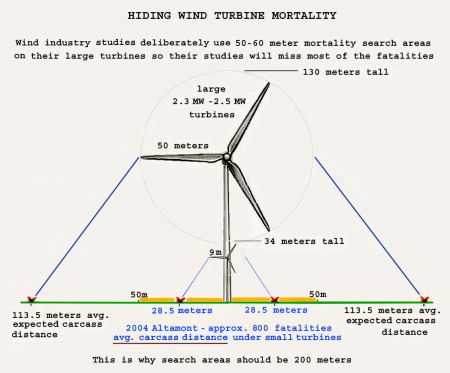 It is not a difficult principle to understand that taller turbines with much longer blades and faster blade tip speeds are going to launch birds hit by turbine blades much further. Blade tip speed, height of blades, and point of impact are the key principles involved. To help people fully understand the influence a larger turbine has on carcasses distance I created an image with a 100 Kw turbine drawn to scale along with a 2.5 MW (SEE IMAGE). If a 100 Kw turbine throws birds hit by turbine blades an average of 28.5 meters then a larger turbine with 25 times the rotor sweep will launch birds hit by blades much further. When using turbine height and blade length and the same angle to the ground produces an average carcass distance of 113.5 meters.
It is not a difficult principle to understand that taller turbines with much longer blades and faster blade tip speeds are going to launch birds hit by turbine blades much further. Blade tip speed, height of blades, and point of impact are the key principles involved. To help people fully understand the influence a larger turbine has on carcasses distance I created an image with a 100 Kw turbine drawn to scale along with a 2.5 MW (SEE IMAGE). If a 100 Kw turbine throws birds hit by turbine blades an average of 28.5 meters then a larger turbine with 25 times the rotor sweep will launch birds hit by blades much further. When using turbine height and blade length and the same angle to the ground produces an average carcass distance of 113.5 meters.
The 113.5 meter carcass distance I listed on the bigger turbines could even be further for two reasons: (1) the blades tip speeds are about 40-50 mph faster on the industry's new larger turbines and (2) The blades on the 2.3 MW-2.5 MW turbines are not as sharp on the edges, so bodies upon impact will be less likely to be cut in half. This will add to the energy absorbed by the bodies of birds and bats upon impact, and probably increase distance.
Carcass distance was a very important factor in the 1998-2003 bird mortality studies because with only a 50 meter search radius, it as noted that searches were still missing a substantial number of fatalities in their searches. Missing carcasses in searches was the reason that the 2004 report suggested that mortality search areas or the search radius from towers needed to be expanded in relation to the size of the turbines being surveyed. A with a minimum of 70 meters was suggested, for even the shortest of turbines currently in operation.
But this was not really new information. Even in the late 1980's researchers were aware of carcass distance when looking for bodies. They used a 100 foot search radius on the smallest 40-65 Kw turbines and a 200 foot (63 meter) search radius for the larger turbines.
Recently a new study or report was released from the APWRA. Search areas for the latest Altamont studies 2005-2010 still used a 50 meters search radius and conducted searches with longer than 30 day intervals. There were many other problems as well.
Problems with the latest Altamont Study- The latest Nov 2012 report from the APRWA was based upon mortality studies conducted from 2005-2010. Though similar in design the results from latest study look very different than the report released in 2004. When comparing these two lengthy studies it can be seen that there are dramatic contrasts in both the number of carcasses found and the estimated annual mortality. The earlier study collected fewer bodies and concluded with much higher mortality estimates. The 2005-2010 study found far more carcasses around their turbines while concluding that mortality at the APWRA had declined substantially.
I have put together a chart with some of the raw figures from the two studies. As it can be seen from the totals, researchers collected nearly 3 times the number of bodies from around turbines. Disproportionately high increases in carcasses totals can be seen across the entire mortality list from the 2005-2010 study. (Insert Chart)
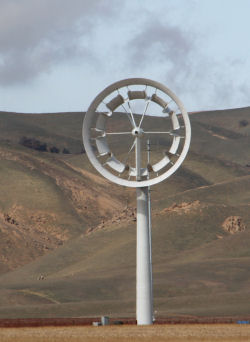 The bird safe wind turbine - Unbeknownst to most people there is a bird safe wind turbine design being produced. It is called the FloDesign Wind turbine. The turbine is a modified propeller/turbine style turbine with an encased design that protects birds from the open blade tips of other turbines. (Image)
The bird safe wind turbine - Unbeknownst to most people there is a bird safe wind turbine design being produced. It is called the FloDesign Wind turbine. The turbine is a modified propeller/turbine style turbine with an encased design that protects birds from the open blade tips of other turbines. (Image) 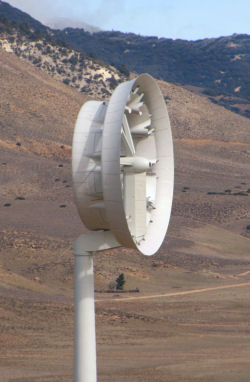 In July 2011 FloDesign made a pitch to the Altamont Pass Wind Resource Area Scientific Review Committee. This company wanted to install several test turbines at Altamont Pass so they could prove this turbine was bird safe. There were plans to have this turbine installed by the end of 2012. For some reason this has been all been delayed. But it would seem that with an ongoing bird kill disaster at Altamont, that this turbine would be installed as soon as possible. At the very least one would think this turbine would be used to immediately replace the most dangerous turbines.
In July 2011 FloDesign made a pitch to the Altamont Pass Wind Resource Area Scientific Review Committee. This company wanted to install several test turbines at Altamont Pass so they could prove this turbine was bird safe. There were plans to have this turbine installed by the end of 2012. For some reason this has been all been delayed. But it would seem that with an ongoing bird kill disaster at Altamont, that this turbine would be installed as soon as possible. At the very least one would think this turbine would be used to immediately replace the most dangerous turbines. Altamont Pass turbines kill fewer birds................ http://www.sfgate.com/business/article/Altamont-Pass-turbines-kill-fewer....
Developing Methods To Reduce Bird Mortality In The Altamont Pass Wind Resource Area 2004-08-11
http://altamontsrc.org/alt_rl.php
ALTAMONT PASS WIND RESOURCE AREA BIRD FATALITY STUDY, BIRD YEARS 2005–2010 November 2012
http://altamontsrc.org/alt_doc/m87_draft_2010_2011_bird_year_monitoring_...
ALTAMONT PASS WIND RESOURCE AREA BIRD FATALITY STUDY, BIRD YEARS 2005–2009 September 2011
http://altamontsrc.org/alt_doc/m73_altamont_pass_wind_resource_area_bird...
The opinions in this editorial reflect the views of the author and do not necessarily reflect the views of East County Magazine. To submit an editorial for consideration, contact editor@eastcountymagazine.org







Comments
Enlightening Article!
I also want to thank you for this article, Jim. I'm glad you have the depth of knowledge and commitment to take on the wind industry and present the truth with the FACTS about wind turbines killing birds. Your text, chart, diagram and photos give clarity to someone like me who isn't an expert, and helps me to have even more confidence in the stance I have taken against wind turbines.
I hope the wind turbine with the "bird-conscious" design proves out! However, I agree with Craig that there are other unresolved issues (some that can never be resolved) pertaining to the negative aspects of wind turbines.
Our efforts and money should be focused on renewable energy sources (such as rooftop solar) that already have proven results and support from the public, including the residents of Ocotillo, Jacumba, Boulevard, Alpine, Lakeside, Santee, etc., instead of wasting them on trying to improve wind turbines that don't.
Excellent piece of writing
Excellent piece of writing and research. Thank you, Jim.
Bird safe turbines may be better, but still leave unaddressed two major problems which, in my opinion, are serious enough justify scraping the wind power idea entirely: 1) Expense; and, 2) Damage to the land.
--Wind power is heavily subsidized by the government. On its own, it can't compete.
--Wind and solar farms eat up vastly more land than any other form of energy production. We need to concentrate on energy production that is, literally, concentrated--takes up--destroys!--less space.